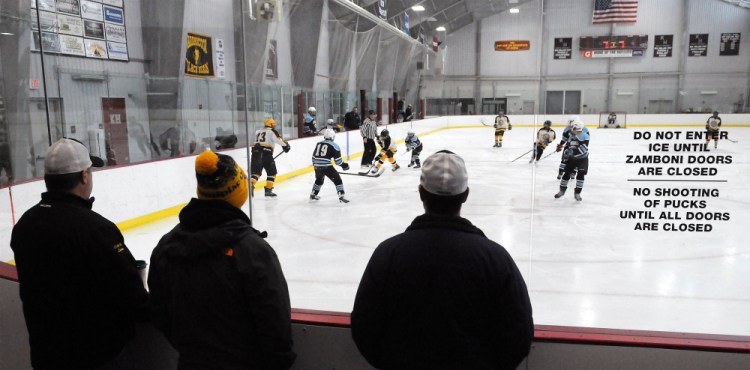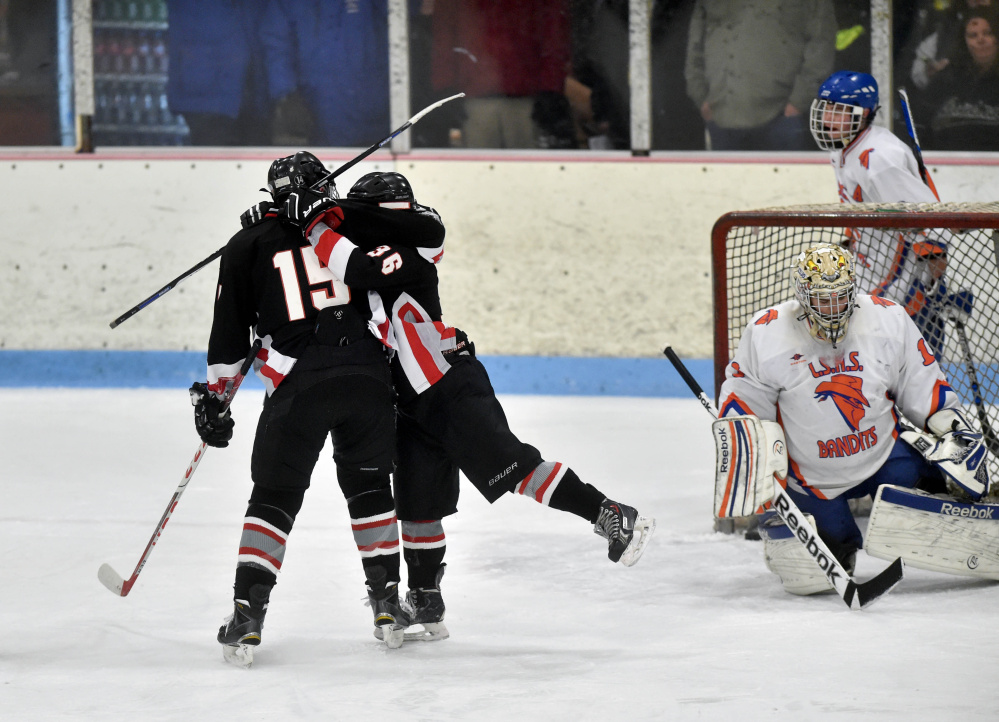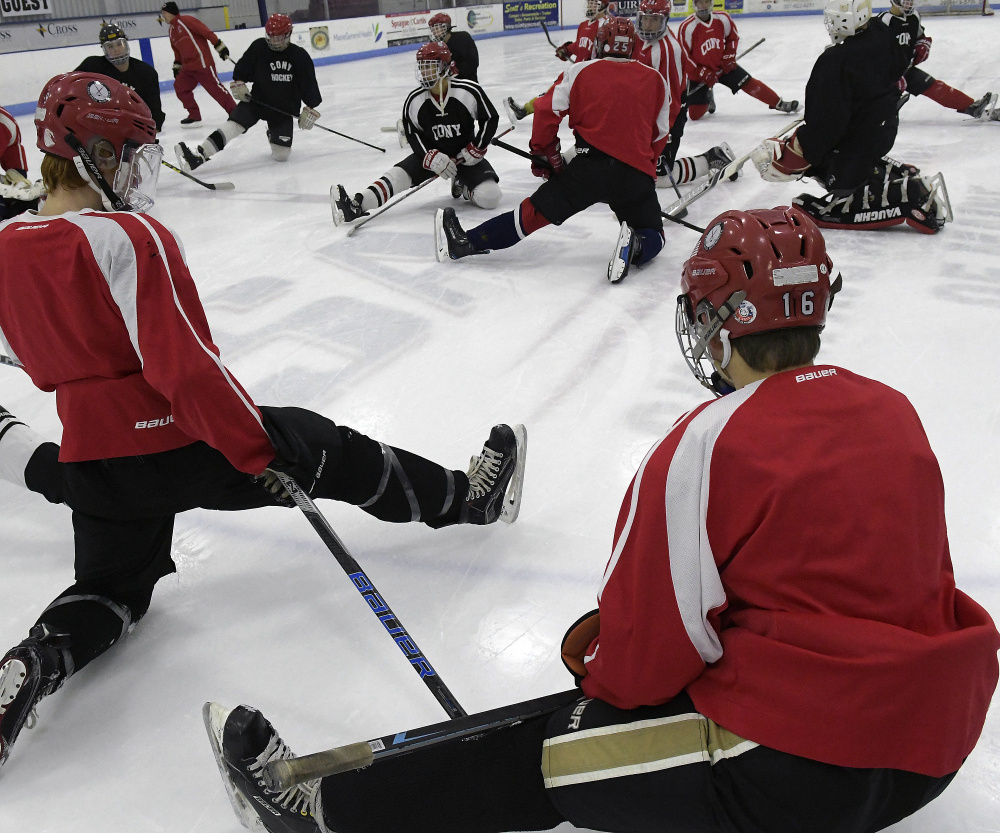Less than 72 hours before the boys ice hockey state championships were to be decided at the Androscoggin Bank Colisee in Lewiston last winter, some of the biggest names in Maine’s high school hockey circles were discussing the sport’s ever-changing landscape. Scarborough head coach Norm Gagne, a member of the Maine Sports Hall of Fame as the winningest hockey coach in state history, couldn’t believe that Waterville — one of his former coaching stops — was about to make history of its own.
When this season opened, Waterville became the first hockey program in state history to win a championship and then fail to field a standalone team the following winter. Waterville joined with Winslow this year to form the co-operative Kennebec RiverHawks.
“Hockey in the state of Maine is really hurting,” Gagne said last March, addressing what were then just rumors of a Waterville-Winslow co-op, one that would end one of the fiercest rivalries in the game. “It’s so sad for that area. You’re seeing some of the tradition washed away.”
Co-operative boys hockey programs are on the rise in Maine and the number of teams are dwindling. According to the Maine Principals’ Association, co-ops debuted in Maine in 2000, with three of the 46 teams having entered into a partnership. Today, there are just 36 boys hockey teams, and 14 of them — nearly 40 percent — are co-ops.
Why the drastic change?
Observers point to lack of ice availability, rising costs in the sport, as well as declining school enrollments and youth program numbers, as primary factors.
Making of a co-op
In Aroostook County, Houlton and Hodgdon formed a co-op in 2000 that still exists today. Hall-Dale and Winthrop joined together that year, as did Monmouth and Lisbon. All three teams competed in Class B.
The landscape in the 17 years since has changed dramatically. Today, there are 14 boys co-ops. Girls hockey debuted in 2009 with one co-op among its 17 teams. Today, 12 of the 16 teams are co-ops.
In the boys game, there are fewer hockey teams in the state today compared to 17 years ago, because participation is down. For every Lewiston High School, which had 49 players try out for varsity and junior varsity teams last month, there are teams scrambling to put a team on the ice. For example, Messalonskee — which won Class B state titles in 2014 and ’15 — entered the season with just nine skaters and two goalies.
Many co-op teams today also include more than two schools, which is also more common today.
In 2010, only one of the seven co-op teams featured more than two schools — Maranacook/Winthrop/Hall-Dale. This season, nine co-ops are comprised of three or more schools, with two teams featuring four schools. A total of 39 schools contribute players to the 14 co-ops, with 10 of those schools providing four or fewer players.
“There were co-ops before, but not like there are today,” said Mike Burnham, a Maine Principals’ Association director.
Shrinking enrollments
There are fewer students in many high schools today across Maine, and there are also fewer youth hockey players.
According to the Maine Department of Education, Waterville Senior High School had 765 students in 2000. As of last April 1, that enrollment dropped more than 32 percent to just 517 students.
Cony/Monmouth/Hall-Dale coach Chad Foye, now in his 22nd season, coached the Rams as a standalone program in the late 1990s and early 2000s, when it was one of central Maine’s hockey mainstays. In 2000, Cony had 985 students.
But enrollment slowly dropped — Cony had just 623 students last April 1 (a 37 percent drop) and the program entered a co-op with Monmouth in 2013. Hall-Dale joined two seasons later.
“It was a situation where a lot of these guys had played together growing up, and the numbers were going to start dropping off,” Foye said. “It evolved that way. … As you get older, you start looking at some things. You start looking at different things and you kind of see it developing. As I started coaching, I could envision it happening.”
Youth movement
A decline of numbers in youth hockey — at nearly every age group — has also impacted the high school game.
The Central Maine Youth Hockey Association in Waterville, has seen its participation numbers dip over the last five years. In 2013, CMYHA had 183 players across five skill levels. That number swelled to 225 with the addition of two travel teams in 2015. Last winter, however, those numbers dropped to an all-time low of just 155 players across five levels, prompting the organization to drop two teams at its top levels this season — one at Bantam (13-14 year-olds) and another at PeeWee (11-12 year-olds). Central Maine Youth Hockey says it has 164 players today, including more than 70 at the Learn To Play level that encompasses the youngest players. This means more than 40 percent of the players in CMYHA are between 3 and 5 years old.
“It dipped to a low for us last year, so we did a lot of advertising, made a lot of contact with pre-schools this year,” CMYHA president John Robertson said. “We really pushed for registrations in that age group. We were aiming for a 10-15 percent increase.”
Instead, they got a nearly 25 percent increase at Learn To Play — the cost of which is free to participating families, subsidized almost entirely through donations from area business. In most cases, any additional equipment needed is also provided free of charge. Additionally, CMYHA budgets $4,000 annually toward scholarships to keep kids playing hockey, Robertson said.
“People just can’t afford to play hockey. It’s got kind of a reputation of being a real expensive sport,” Foye said. “A kid comes home with a big hockey flyer, and the first thing (parents) think is, ‘I’m not getting up at 3 a.m. to go to practice and spending $900 on a pair of skates.’ You don’t have to do that, but hockey has that reputation. That’s one of the things that’s led to (the decline).”
Without an increase in Learn To Play players this season, CMYHA would have been at an all-time low for participation. The costs to play, coupled with the shuttering of Sukee Arena in Winslow, Robertson said, are contributing factors to those 3- and 4-year olds not remaining with the group through their Bantam years at the U-14 level.
Ice availability
Available ice time has long been impacted the sport, but it’s been magnified in central Maine since Sukee closed.
The Lawrence/Skowhegan/MCI co-op practices at Colby College in the early mornings and, when it can get ice time, at Bonnefond Ice Arena on the Kents Hill campus in the evenings.
At the youth level, Robertson said the closure forced parents — particularly those who live within 20 miles of Waterville — to choose between CMYHA or making a longer drive to Bangor or Hallowell to play consistently in the same location two to three times a week with a different organization.
“The loss of Sukee Arena was the only stimuli to effect our registrations,” Robertson wrote in an email. “We did not have any other changes in costs, travel or team requirements that was different from years prior. … Kids need to be constantly on the ice, working on edges, touching the puck, working on touches, passing and shooting. Everything is muscle memory. You have to have the opportunity for them to do it in order to improve.”
Messalonskee High School coach Kevin Castner, whose team is skating with dangerously low numbers, agrees. Late last season, the team’s first without Sukee Arena, he noticed that he was still working on conditioning and basic-systems play instead of fine-tuning game plans or working on special teams as the Eagles fought to make the Class B North playoffs.
The Eagles missed out. Less than three years removed from a second consecutive state championship in 2015, Messalonskee is without a home rink, facing debilitating numbers and battling defections to other out-of-school hockey programs.
“The loss of Sukee Arena was catastrophic to some of the programs in the area,” Castner said.
Growing the game
The need for co-operative varsity hockey programs to keep the sport viable in Maine is evident. Their growth in the 17 years — particularly booming since 2010 — suggests the need for them.
Lewiston hockey coach Jamie Belleau, who has won the last two Class A state championships with a standalone team, thinks even more can — and should — form to ensure that co-ops provide an opportunity for every player willing to play hockey.
“Despite the fact that there’s a lot of places for players to play other than on high school teams, there are still too many kids that can’t — for whatever reason — participate in those other programs,” Belleau said. “If people don’t recognize the issues, then we’re in trouble.”
Players are being pulled in more directions these days — to junior programs like the Maine Moose, to prep schools and to full-season Midget (U-18) teams. Somewhere, participation numbers have to give, and right now, at least in Maine, it’s happening at the high school level.
One of the ways programs are fighting to recoup some of those lost numbers is through the inclusion of just a handful of players from smaller schools, who historically were unable to field their own teams.
“The issue is more the hockey model throughout the United States, not just in Maine,” Belleau said. “There are so many programs available for kids, for a number of factors, so you’re going to see natural attrition (in high school programs). You might see it more quickly in some areas than in others. It’s nobody’s fault — the U.S. hockey model youth programs follow, it allows for a number of different programs.
“It’s just a reality that’s part of the hockey model, and it starts to impact some communities quicker than others. Sanctioned organizations, unsanctioned organizations, it’s players and their parents having a number of opportunities to play in different areas. That’s just the way it’s going to be.”
Belleau praised the MPA for tweaking how it classifies programs based on enrollments.
Previously, total school enrollments were used to place a co-operative team in a class. Now, the MPA counts the host school’s enrollment as well as a percentage of the secondary schools’ enrollment that is equal to the percentage of athletes from that school.
For example: Host School A has 500 students. Co-operative School B has 400 and contributes 10 of the 50 athletes on a team, or 20 percent of the team. In the new system, the co-op would be considered to have an enrollment of 580 (500 from the host school plus 20 percent of 400) as opposed to 900 under the old system.
“Particularly from both the MPA and high school perspectives, and serving high school athletics at the hockey level, it’s about those kids,” Belleau said. “If the state of high school hockey is affected, we may have the numbers (in Lewiston), but we won’t have a place to play anymore. We’ve got to all work together to recognize the issue. We have to put our heads together, roll up our sleeves and get to work. I can’t emphasize this enough.”
Travis Barrett — 621-5621
tbarrett@centralmaine.com
Twitter: @TBarrettGWC
Send questions/comments to the editors.






